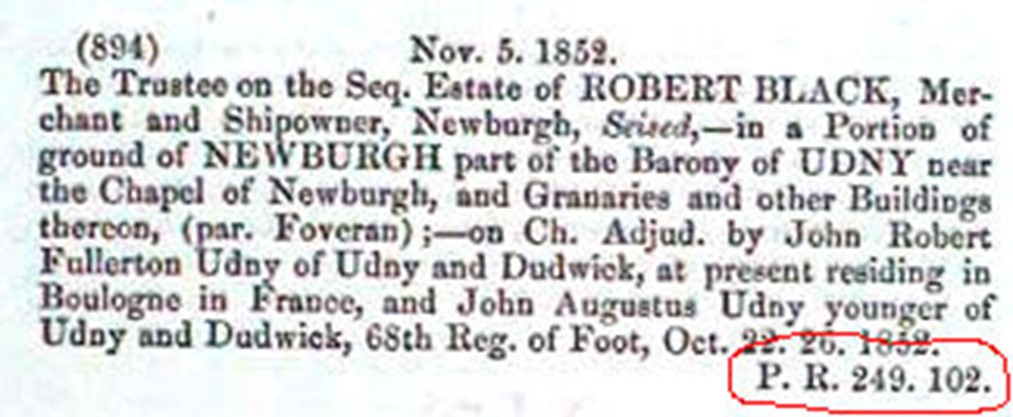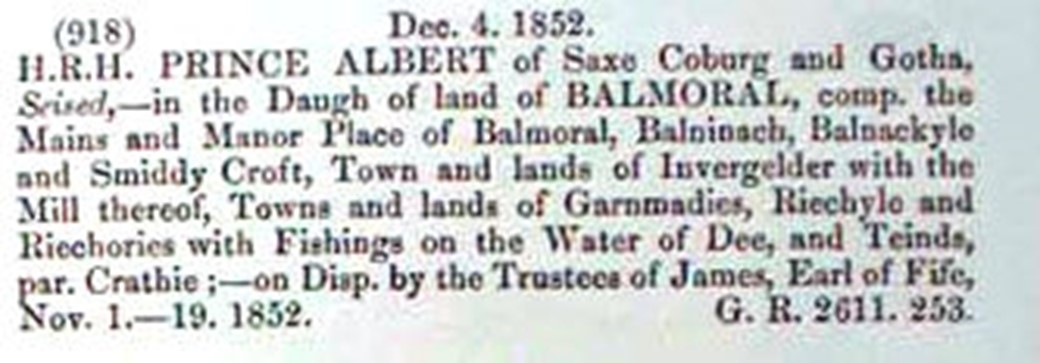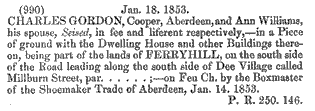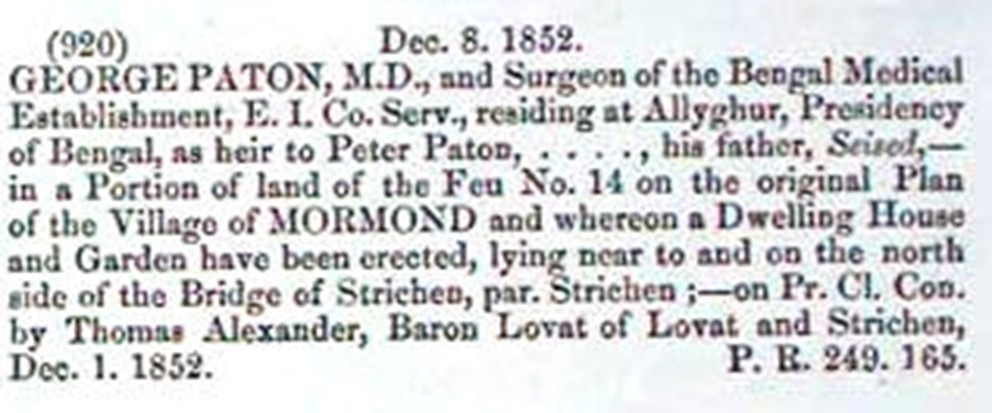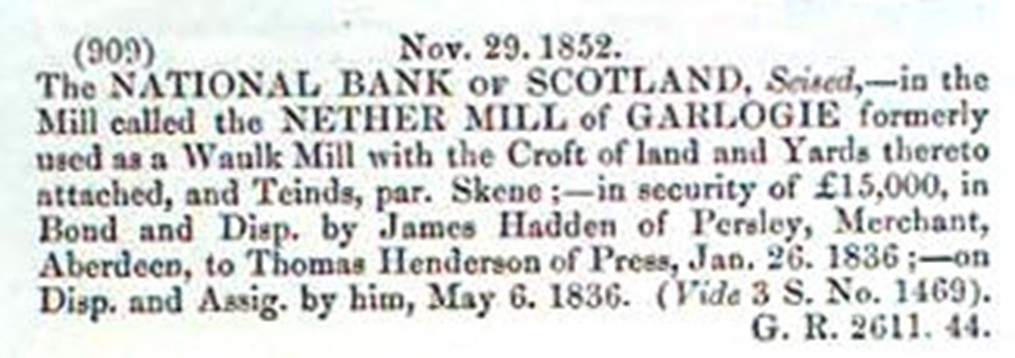Valuation Rolls
Valuation rolls are lists of properties and their owners, compiled for the purposes of local taxation, known as rates. The rates were levied by local authorities for various purposes, such as poor relief, schools, policing, cleansing, new streets, or public health. From at least the early 17th century to 1855, valuation rolls were compiled intermittently, by different local authorities, such as the commissioners of supply in counties or burgh councils or sometimes by other bodies appointed to collect a stent, cess or other assessment. Between 1855 and 1989 valuation rolls were compiled annually by county and burgh assessors following formats and timetables laid down by legislation. After 1989, the basis for local taxation changed and domestic properties were removed from valuation rolls. Instead, domestic properties were covered by community charge rolls (1990-1993) and then council tax rolls (1994 onwards); while valuation rolls continued to be compiled for non-domestic properties only.
Land Tax Rolls, 17th century-1855
Valuation rolls were compiled by the Commissioners of Supply, the body of landowners in each county responsible for collecting the land tax from 1667.[1] The principal purpose of these land tax rolls was to record who owned which property (worth more than £100 Scots), how much each property was worth in terms of annual rent, and what the owner’s liability was in terms of taxation based on the rental value. Rolls for each county were compiled only sporadically and those for the 17th century and early 18th century normally list the estate names rather than the names of the owners. From the mid-18th century land tax rolls became more elaborate, recording the name of the estate, the owner, and (sometimes) the tenant or occupier. The holdings of leading landowners were sometimes subdivided into smaller estates. However, the valuation rolls compiled in royal burghs for the land tax list only the properties and their values, and not the names of the owners.
Under the County General Assessment Act 1868 the Commissioners of Supply were required to raise funds by rating.[2]
Valuation Rolls 1855-1989
Valuation Rolls between 1855 and 1989 were compiled annually by assessors appointed in each county and each royal or parliamentary burgh.[3] The format and contents were laid down by legislation, as were the annual deadlines for compiling the information, resolving appeals and publishing the rolls. The valuation rolls included all properties whose actual or theoretical annual rental value was estimated to be above a statutory minimum, initially £4 per annum along with the names and designations of the proprietors and the tenants. The rolls include the location and description of the property, what kind of property it was (e.g. dwelling house, shop, warehouse, hospital etc), the name and designation of the owner (proprietor), the name of the occupier (the tenant if the property was let or the owner if not) and, in some cases, the name of other occupants (if the property was sub-let, for example) and yearly rent or rateable value. Until the mid-20th century the rolls also included the occupation of most tenants and occupiers.
County rolls were subdivided by civil parish (and sometimes sub-divided by landowner, rather than address). Burgh rolls, from the early 20th century, were increasingly divided into municipal wards. In 1975 when regional assessors replaced the county and burgh assessors, the format of the valuation rolls changed.[4] Each region’s rolls were subdivided into local government districts, and these into wards.
Every six years, the assessors were required to send copies of the previous six years of valuation rolls to Register House in Edinburgh (now National Records of Scotland).
Non-domestic valuation rolls 1990-present
Valuation rolls after 1989 for non-domestic property (which paid business rates) continued to be produced annually.[5] These no longer included details of domestic and other types of non-commercial property.
Community charge (poll tax) records 1989-1993
In 1990 the community charge (or ‘poll tax’, as it was more popularly known) replaced domestic rates as the principal basis for local taxation. [6] This was a flat rate charge per adult (with a reduction for certain categories such as students and registered unemployed) and therefore the registers recorded the name and address of individuals liable to pay this tax.
Council tax valuation lists 1993-the present
The community charge was replaced by the present system of council tax in 1994.[7] Council tax valuation lists record addresses and the council tax band that applies to that address.
Where to find valuation rolls
Land tax rolls are held in the National Records of Scotland (NRS) and digital copies are available on the Trove website < https://www.trove.scot/> [accessed 26 May 2025]. Some of these pre-1855 valuation rolls can be found in local authority archives among the Commissioners of Supply records for each county. Burgh assessment rolls may also be found in local authority archives. Another series of early valuation rolls is found among the records of the Inland Revenue in the National Records of Scotland (reference IRS/4), which covers 9 counties.
Complete series of valuation rolls, 1855-1989, for the whole of Scotland, by county, burgh or (after 1975) region, are held by NRS: indexed digital copies of these are available on the ScotlandsPeople website (fees apply) <https://www.scotlandspeople.gov.uk/> [accessed 26 April 2024]. Some local authority archives services and local studies libraries hold less comprehensive runs of valuation rolls for particular counties, burghs and regions.
NRS holds copies of all the registers of people in Scotland liable to pay the community charge. Some local authority archives may also hold local copies.
NRS holds complete copies of all council tax valuation lists. Some local authority archives may also hold local copies.
Who uses valuation rolls
Valuation rolls are a key source for local and building history, showing who lived in a house, which estates owned large numbers of properties, where businesses and industries were located and how this changed over time. They are frequently used to identify economic changes as the types of buildings and their values changed. Family historians can use valuation rolls to find individuals and see how long they lived at an address: this task has become easier now that many valuation rolls have been indexed and are available digitally. However, care should be taken to ensure that individuals with the same name are not confused and it should be noted that only the people liable for paying the rates are listed and not the entire household.
Valuation rolls are also used for non-historical research such as by the owners of buildings to establish a previous use of the building when applying for planning permission; by individuals to establish proof of tenancy or residency; by credit agencies and prospective employers, in confirming residential status; and by the police in criminal investigations.
Contributors: Bob Brown, (National Archives of Scotland, 2002) Robin Urquhart, Andrew Jackson (both SCAN, 2002), Elspeth Reid (2021)
Bibliography
National Records of Scotland Tracing Your Scottish Ancestors (Birlinn, 2020)
Sinclair, Cecil Tracing Scottish Local History (HMSO,1994)
References
[1] Act of the convention of estates of the kingdom of Scotland etc, 1667. The Records of the Parliaments of Scotland to 1707 [RPS] ed. by K.M. Brown and others (University of St Andrews: 2007-2021) 1667/1/10 http://rps.ac.uk/trans/1667/1/10 accessed 18 May 2021.
[2] County General Assessment (Scotland) Act 1868 (31 & 32 Vict. c.82).
[3] Valuation of Lands (Scotland) Act 1854 (17 & 18 Vict. c.91).
[4] Local Government (Scotland) Act 1973 (c.65).
[5] Abolition of Domestic Rates Etc. (Scotland) Act 1987 (c.47).
[6] Abolition of Domestic Rates Etc. (Scotland) Act 1987 (c.47).
[7] Local Government Finance Act 1992 (c.14) ss.70-99.
Were valuation rolls compiled during wartime?
Yes, valuation rolls were compiled during wartime
Why are valuation rolls for Lanark County (with few exceptions) available only in Edinburgh?
One copy of each valuation roll produced by the Lanark County Assessor was sent to Edinburgh to be kept for historical and legal research at Register House (now the National Records of Scotland). Another copy was kept by the Assessor’s office in Lanarkshire. When the Scottish counties and burghs were abolished in 1975, the surviving valuation rolls (and voters’ rolls) Scotland’s city, district and regional archive services attempted to preserve the valuation rolls and voters rolls for their areas. In most cases they were successful. In the case of Lanark County, the valuation rolls and voters’ rolls belonging to Lanark County Council were removed or destroyed, either by staff in the outgoing County Assessor’s office or by local officials in the successor authority, Strathclyde Regional Council, before staff from the newly created Strathclyde Regional Archives could secure them for preservation. Among the Lanark County records held by Glasgow City Archives there is a valuation roll for Lanark County for 1894, and among the records of several civil parishes with the Lanark County records there are series or individual rolls for those parishes. The National Records of Scotland hold valuation rolls for Lanark County from 1855 until 1975.
If I don’t know someone’s address, can I find his or her details in a valuation roll?
Not very easily. Firstly, the person must be the head of the household (as far as the Assessor is concerned): either the owner or tenant of the property. Secondly, the roll is arranged by the address of the property. The indexed digital records will be helpful for those years that are currently available, but for the unindexed original records you would have to search through randomly occurring surnames (i.e. the surnames are not in alphabetical order). Thirdly, the only distinguishing information between people with the same name is their occupation and it is easy to confuse individuals: it may not be possible to tell the difference between a father and son with the same occupation. It may therefore take about an hour or two to work through the roll for a small community – a village or small town. For larger towns and cities, it would require several days to search through the whole roll.
How do I find an address in a Glasgow valuation roll?
For the period 1913-1989, Glasgow valuation rolls survive at the National Records of Scotland; at Glasgow City Archives; and at the History and Glasgow Room of the Mitchell Library in Glasgow. Valuation rolls for this period are arranged by ward, but every few years there were changes to the boundaries and numbering of wards. You need to consult a street index to find out which ward a street was in at any given year. Glasgow City Archives have street indexes for the period 1913-1995. The National Records of Scotland have a street index for 1875. For the period 1855 – 1912 valuation rolls for Glasgow survive only at the National Records of Scotland. The Glasgow rolls are divided into volumes for Glasgow Burgh, Glasgow Barony, Govan Parish and Gorbals Barony. There is an index of streets compiled from the 1875 valuation roll, which tells you which of the volumes a street is in, but the index is not entirely accurate for the period after 1878, because of boundary changes involving Glasgow burgh. Glasgow City Archives have a database index of owners and occupiers from valuation rolls for 1861, 1881 and 1891. For further details contact Glasgow City Archives.
What information does a valuation roll contain?
A valuation roll records details about each property which was liable for domestic rates (local taxation) for a particular year, in the period 1855-1989. It records the address of the property, the type of property (e.g. a house, factory, hotel, inn, shop etc), the owner, the tenant (if the property is not occupied by the owner), and, sometimes, other occupants (for example where a tenant has sub-let the property). In 19th century rolls and rolls for the first half of the 20th century, the occupation of most tenants and occupiers are given. The roll also records the rateable value and gross annual value of each property: these were used to calculate the level of rates (local taxation) paid for each property.
Are valuation rolls useful sources of information for family history?
If your prime interest is in obtaining dates of birth, marriage and death for ancestors, valuation rolls will not be much use. If you are ‘putting flesh on the bones’ of your family tree, valuation rolls might be useful, as they contain information about individuals such as whether they owned or rented their houses, what their occupations were, and what sort of house and neighbourhood they lived in (by comparing the address and its occupants with others nearby). However, research in valuation rolls can be time-consuming and may simply confirm information about an individual you already know from other sources. There is, however, one use which valuation rolls can be put to with good effect in family history, and that is to identify the nature of a building recorded on a birth or marriage certificate. For example, the marriage or birth certificate might simply state an address, which the valuation roll might confirm was a hotel, church, private house, hospital or poorhouse.
Are valuation rolls useful for tracing missing persons?
Not really. Valuation rolls for domestic properties have not been compiled since 1989, so are now out of date. Secondly they are usually arranged by street, not by personal name. Electoral rolls are slightly better, because they are updated annually and include the names of more people, although Electoral Rolls, again, are arranged by street name. It is possible to buy databases of voters rolls, produced commercially. For further advice on tracing someone you have lost track of read Colin D Rodgers, Tracing Missing Persons: an introduction to agencies, methods and sources in England and Wales (Manchester University Press, 1986).
If I am having trouble finding an address in a valuation roll, why might this be?
Valuation rolls can be difficult to search through. Often a particular address or building does not seem to appear where it should in the roll.
See below for details of common problems and what to do.
Odd and even street numbers
Valuations rolls almost always record the properties on one side of the road and then the other. In most cases, therefore, the odd numbers will be recorded then the even numbers. Before 1975 most valuation rolls record properties in each street by running up the odd numbers (1, 3, 5, 7 etc) and, once the end of the street has been reached, running back down the even numbers (e.g. 36, 34, 32 . . . etc).
What to do: double-check the numbering to make sure you haven’t missed a street number.
Street intersections
In the 19th century and early 20th century, Assessors enumerated streets as far as an intersecting street, then enumerated the intersecting street before continuing with the first street. For example, if Main Street was intersected by Kirk Street, the relevant part of the valuation roll might look like this:
45 Main Street
47 Main Street
49 Main Street
1 Kirk Street
3 Kirk Street
5 Kirk Street
6 Kirk Street
4 Kirk Street
2 Kirk Street
51 Main Street
53 Main Street
55 Main Street
What to do: Double check the numbering, taking into account intersecting streets
Municipal boundaries
A street might start in a city, burgh, parish (or post 1975 local government unit) and continue in another. For example, in the 1890 valuation roll for Glasgow numbers 2-156 Argyle Street were in Glasgow City, while Argyle Street from number 158 onwards were in Barony Parish. Each part of the Street was in a different valuation roll. In some cases a whole town or village straddles a boundary. The town of Barrhead, for example, was partly in Neilston Parish and partly in Abbey Parish, in two separate divisions of the Renfrewshire valuation roll. The village of Busby was partly in East Kilbride Parish, Lanarkshire, and partly in the parishes of Mearns and Cathcart, Renfrewshire.
What to do: refer to a contemporary map or gazetteer to find out if a place was divided by a municipal boundary.
Ward boundaries splitting streets
Streets make ideal physical features for ward boundaries, so it is common to find a street where one side (the odd numbers) are in one ward, while the other side (the even numbers) are in another ward, in different parts of the valuation roll. In addition, a street might be bisected by a ward (or parish or burgh) boundary and appear in two or more parts of the valuation roll.
What to do: if there is no street index available, check if the valuation roll for the parish/burgh/city is divided into wards and check each ward for different parts of the street.
Boundary changes
The boundaries of cities, burghs and parishes change periodically, and this can affect valuation rolls, much as it affects other records such as census returns. A street or place might appear in the valuation rolls for a certain parish for several years, then apparently disappear. This may be because a boundary has changed and the street or place is now within a different parish, or been annexed by a burgh or city.
What to do: refer to contemporary maps and gazetteers to find if a place has been affected by a boundary change.
Local government reorganisation
The local authorities which were required to appoint assessors changed several times due to local government reorganisation. In 1889 there were boundary changes to the counties. From 1855 to 1930, royal burghs and parliamentary burghs had their own assessors who compiled separate valuation rolls while other burghs were included in county valuation rolls. From 1930 to 1975, a new system of cities, large burghs and small burghs was set up, and only cities and large burghs appointed their own assessors to compile valuation rolls, while all other burghs were included in county valuation rolls.
What to do: Check the history of a burgh to find out if it was a royal or parliamentary burgh before 1930 and if it was not, then look at the county valuation rolls. For burghs after 1930, look at the List of Counties, Cities, Large burghs, Small burghs to identify which burghs created valuation rolls and which were included in county valuation rolls. County and burgh boundaries can be seen on historic Ordnance Survey maps many of which can be accessed online through the National Library of Scotland website.
Street name changes
Sometimes the name of a street changes. This may reflect the way a street is commonly referred to, or else the change may be the decision of the municipal authority for the place concerned. Where city boundaries expand and bring in streets, whose name already occurs elsewhere in the city, one of the streets may be renamed in order to prevent confusion.
What to do: refer to contemporary maps and postal directories, or, where available, published guides to street names.
Multiple frontages
Where a large building (especially commercial and industrial properties) occupies a site which fronts onto two or more streets, the valuation roll may record the property under only one address (what the Assessor regards as the postal address). For example, a shop may have entrances at Main Street and Kirk Street, but may appear in the roll only under Main Street.
What to do: refer to contemporary maps.
Terraces and courts
The recording of terraces, courts and other minor streets may change over time in the rolls. A row of houses, or cluster of buildings, might begin life under one name, but eventually be classed as part of a longer street. For example, a row of five houses might originally be recorded as 1-5 Kirk Terrace, but these might be renumbered 54-62 Kirk Street, when the numbering of the street is simplified.
What to do: refer to published street name guides, where available, or else contemporary maps and postal directories. If the street involved appears in the valuation roll for one year, but not the next, check the names of the owners and occupants of the street in the first year, and try to find the matching names in the next year’s roll.
Building not rated
Only buildings over a certain value (originally an actual or theoretical value of £4 in annual rent) were liable for local rates. If the building was a comparatively modest one, therefore, it may not appear in the valuation roll. The building would have to be very modest indeed, however, since categories of buildings which were rated and do occur in valuation rolls include advertising hoardings and garages.
Unnumbered buildings
Sometimes buildings (particularly newly built buildings) are not given a street number in the rolls until the numbering of the street has been formally determined. The property may be known now as ‘175 Kirk Street’, but until fairly recently it may be referred to in the rolls as ‘cottage, Kirk Street’.
What to do: check the valuation roll carefully about the street number in question, looking for buildings without a number which might fit the description of your property.
Administrative time lag
New buildings take time to appear in the valuation roll. A building completed in November 1875, say, would not appear in the 1876 valuation roll (because the Assessor’s survey for that roll was carried out in the Autumn of 1875). It might make its first appearance in the valuation roll in 1877.
What to do: bear in mind the time lag for information reaching the valuation roll.
Subdivisions, e.g. railway, government property etc
Some valuation rolls have separate divisions for different types of property, for example, railway property, central government property, local authority housing and other buildings, and agricultural and sporting property.
What to do: check the valuation roll thoroughly, particularly the final pages of each parish, burgh, or ward.
The source of your information might be wrong
If you cannot find a property in a valuation roll, you should consider whether the information you have about the building is correct. For example, it is not uncommon to find erroneous information in published architectural guides (for example, giving erroneous dates for the construction of a buildings), or for someone to muddle a street number, street name or building name.
What to do: valuation rolls are difficult to search without accurate information about street names and numbers. Consider other sources of information, including postal directories.
Clerical Error
As with any official record, the possibility of clerical error cannot be ruled out. An error could be made at the point of survey, or while the roll was prepared for printing, or in the printing process.
What to do: check the valuation rolls for the following years to see if an error is rectified later.
Why might a person not appear in a valuation roll at an address he or she was resident at?
There are five main reasons why someone may not appear in a valuation roll.
Not the householder or owner
Remember that the purpose of a valuation roll was not to record the names of all residents at a property, but to record merely those liable for local rates: the owner and – if appropriate – the tenant. A person may have been resident at a property but not mentioned in a valuation roll because he or she was not the owner of the property or the tenant. For example, a married couple might have been resident but if the husband or wife was the tenant, the other spouse will not be named. If the person concerned was a subtenant he or she would not be mentioned.
Unofficial house swap
Sometimes the tenants of two houses swap houses informally, between themselves, without changing the lease. This happened particularly between tenants of council houses. Tenants might swap to be nearer family or because a bigger or smaller house is required. If this is done without formal permission from the owner of the property, the valuation roll will not be changed to reflect the informal arrangement.
Administrative time lag
Because valuation rolls were almost always published once per year, they do not take into account changes until the following year. In general county and burgh surveyors surveyed properties in the Autumn and published the roll based on this survey the following Whitsun (15 May). So, for example, a roll published on 15 May 1925 contains information about properties gathered in the Autumn of 1924. A new tenant might move into the property in December 1924, but not appear in the valuation roll until May 1926.
Clerical Error
As with any official record, the possibility of clerical error cannot be ruled out. An error could be made at the point of survey, or while the roll was prepared for printing, or in the printing process.
False information
Owners or occupiers might give false information at the point of survey, deliberately (for example to avoid taxation) or accidentally (for example, a husband or wife giving his or her name as tenant, when, strictly speaking the tenant was the other spouse).
How can valuation rolls help me prove I was a tenant for a number of years?
Because valuation rolls record the name of the tenant and the owner of each property, they are accepted as evidence of a tenancy for some purposes.
To use valuation rolls in this way, someone has to search back through the valuation rolls for period concerned. This typically takes an hour or two but becomes more complicated and time-consuming if the tenant rented several houses in succession. There will be charges for providing copies and there may be charges for the search.
Valuation rolls do not provide exact dates of tenancy. There are, however, limitations, which should be borne in mind:
(1) Valuation rolls record only heads of household (in theory, the person whose name was on the lease). If the spouse of a tenant, or some other member of the household, wishes to prove residence, they may need to use voters rolls in addition to the valuation roll: i.e. the valuation roll proves that the house was a council house, but only records the head of the household, while the voters roll records the names of the other adult members of the household.
(2) Valuation rolls were published once a year (in May, until 1975; in April thereafter).
The information was gathered in the Autumn of the previous year. So, it takes a valuation roll a year or two to catch up with a change of tenancy. For example: a council tenant moves into 999, Letsby Avenue in January 1968 he then moves to 45, Rebellion Street in October 1975.
In the 1968 roll (compiled Autumn 1967) he is not listed at either address.
In the 1969 roll (compiled Autumn 1968) he is listed at Letsby Avenue.
In the 1975 roll (compiled Autumn 1974) he is listed at Letsby Avenue.
In the 1976 roll (compiled Autumn 1975) he is listed at Letsby Avenue.
In the 1977 roll (compiled Autumn 1976) he is listed at Rebellion Street.
Thus, the valuation roll appears to take two years to catch up with his change of address. In exceptional cases, local archives sometimes hold supplementary rolls, compiled by local Assessors, which record the date that a property appeared for the first time in the roll during the previous year. This is useful where the tenant was the first tenant in a new property
For further reasons why someone may not appear in a valuation roll, see the FAQ – Why might a person not appear in a valuation roll at an address he or she was resident at?
What is the difference between a voters’ roll and a valuation roll?
There are several differences because they were compiled for different purposes:
| Valuation Rolls (1855-1989): | Voters’ rolls (electoral rolls): |
| · Record owners and tenants of property who were liable for local taxation in a particular place.
· Are arranged by local authority area (county/district/burgh/parish/ward) and address · Are no longer compiled for domestic addresses (the last domestic valuation roll was for 1989) · Were usually published each year on 15 May until 1974, then 1 April from 1975 until 1989. · List more addresses than corresponding voters’ rolls, but (since the 1880s) fewer people |
· Record all those eligible to vote in a particular place.
· Are arranged by parliamentary constituency, polling district and (in most cases) address. · Are still compiled annually · Were, and are still, usually published in February each year · List more people than the corresponding valuation roll (at least since the late 19th century), but the valuation roll will mention more properties (since it will include commercial and government property which contain no residential voters). |
Do valuation rolls tell you who owns land?
Land tax (cess) rolls compiled by the Commissioners of Supply from the early 17th to the early 19th century record the names of owners of property worth more than £100 Scots worth of annual rent in each parish. Valuation rolls compiled by county and burgh Assessors, for the period 1855-1974, and by Regional Assessors, for the period 1975-1989, do not include details about the ownership of land directly. They record, on the whole, the ownership of occupied buildings. However, they also include details of shooting and fishing rights on sporting and agricultural estates, some commercial grazing land, and some land used for commercial purposes (for example coal yards).
How do I find the valuation roll for an island or a property on an island?
For the period 1855 – 1974 you need to find out which county and civil parish(es) the island was in. You can do this by closing this box, going to the Knowledge Base home page, and selecting the Gazetteer in ‘Places’.
Why do some valuation rolls have separate lists of ‘service voters’ at the end of the rolls for each parish?
From 1946 onwards ‘service voters’ have been defined as members of HM Armed Forces and their spouses, plus crown servants and British Council employees and their spouses residing abroad. They do not register in the same way as residents and may not necessarily reside in the area of registration. Armed forces’ spouses have the option of registering as residents while in the UK. There were 18,686 service voters registered on the 1999 register.
However, prior to 1946 ‘service voters’ were individuals who occupied properties as part of their conditions of service (e.g. some categories of agricultural employees and domestic servants, such as gamekeepers), and who were enfranchised under the Representation of the People Act, 1884. Separate lists of these appear in the valuation rolls for some counties in the late nineteenth century and the first half of the twentieth century, as laid down in the Local Government (Scotland) Act, 1889, viz.:
Special provisions as to service franchise occupiers – Notwithstanding section nine, sub-section (5), of the Representation of the People Act, 1884, there shall be entered in such column and with such heading as the deputy clerk register may approve, in the valuation roll of each county in the manner and subject to the provisions of the Valuation Acts, the annual value of every dwelling-house, the situation or description of which is entered in the said roll under the provisions of section nine, sub-section (2), of the Representation of the People Act, 1884. No person shall be liable to be rated in respect of such an entry, but the person rated in respect of the occupancy of the lands and heritages which include such dwelling-house shall be entitled to relief against the person (in this Act referred to as a service franchise occupier) occupying the same under him by virtue of any office, service, or employment, in respect of so much of the occupiers consolidated rate paid by him as is applicable to the amount entered in the valuation roll under the provisions of this Act as the annual value of such dwelling-house: Provided that where an arrangement has been made under which a deduction is expressly made in name of rates from the wages or emoluments of any service franchise occupier, this section shall not confer any right of relief as hereinbefore provided.
Why are photocopies of valuation rolls sometimes more expensive than copies of other records?
The cost of photocopying extracts from valuation rolls is sometimes set by Assessor’s offices which deposit the valuation rolls in the local authority archives and library services.


